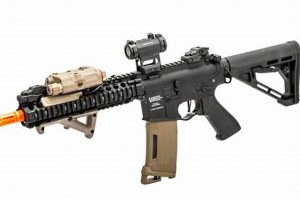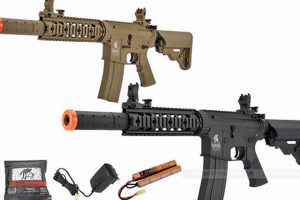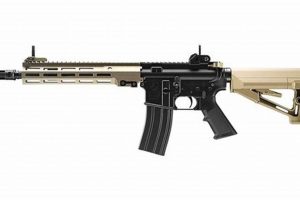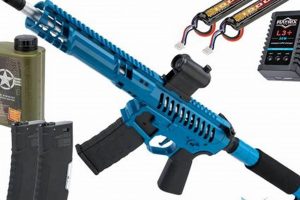This type of airsoft replica employs a manual spring-piston mechanism. Operation requires the user to manually cock the action before each shot by sliding a foregrip, which compresses a spring and loads a BB into the chamber. This mechanism makes them typically single-shot, necessitating a repetitive pumping action between each firing. A common example is a spring-powered shotgun replica used in close-quarters engagements.
The primary advantage of such a system lies in its simplicity and independence from external power sources like batteries or gas. This characteristic translates to a lower operational cost and increased reliability in varying environmental conditions. Historically, spring-powered models were the entry point for many into the sport, offering an affordable and readily accessible option for recreational use. They provide a mechanical directness appreciated by some users, prioritizing user engagement and tactile feedback.
The subsequent discussion will delve into various aspects of these manually operated airsoft devices, including their construction, performance characteristics, tactical applications, and maintenance considerations. Further examination will compare this operation to other airsoft propulsion systems, highlighting their respective strengths and weaknesses in different gameplay scenarios.
Operational Considerations for Spring-Piston Airsoft Replicas
The following guidelines offer insights into the effective and responsible utilization of manually operated, spring-piston powered airsoft devices, also known as “pump airsoft gun”. These suggestions are intended to enhance performance and ensure longevity of the mechanism.
Tip 1: Employ Proper Cocking Technique: Maintain a firm grip and smooth, consistent motion during the cocking process. Avoid abrupt or jerky movements, as these can prematurely wear internal components and reduce consistency of shot velocity.
Tip 2: Utilize High-Quality Ammunition: Employing spherical projectiles of consistent diameter and weight is crucial. Irregular or low-quality ammunition can cause jams, damage the barrel, and negatively affect accuracy and range.
Tip 3: Regular Internal Maintenance: Periodic disassembly and lubrication of internal components, such as the piston head and spring guide, is essential. This reduces friction and maintains optimal compression, leading to improved performance and extended lifespan.
Tip 4: Adjust Hop-Up Appropriately: The hop-up unit imparts backspin to the projectile, increasing range and accuracy. Experiment with various settings to determine the optimal adjustment for the given ammunition and engagement distance.
Tip 5: Store with Released Spring Tension: After use, dry-fire the replica to release tension on the mainspring. This prevents spring fatigue and maintains consistent power output over time.
Tip 6: Prioritize Safety Gear: Always use appropriate eye protection during operation. The potential for ricochet or accidental discharge necessitates the consistent use of ballistic-rated goggles or a full face mask.
Tip 7: Familiarize Yourself with Field Regulations: Prior to engaging in gameplay, thoroughly review and adhere to the specific rules and velocity limits established by the airsoft field or event organizer. Compliance ensures a safe and fair playing environment.
Adherence to these guidelines will contribute to increased efficiency, enhanced reliability, and an improved overall experience when utilizing spring-piston airsoft replicas. Proper care and maintenance are fundamental to maximizing the performance and lifespan of these devices.
The subsequent sections of this article will expand on specific aspects of maintaining and upgrading these airsoft mechanisms.
1. Spring power
Spring power forms the foundational mechanism for this type of airsoft device. It dictates the operational characteristics and performance parameters. Understanding the aspects of spring power is essential for comprehending the capabilities and limitations inherent in such systems.
- Mechanical Energy Storage
The primary role of the spring is to store mechanical energy. The user transfers energy through the pumping action, compressing the spring. Upon release, this stored energy is rapidly converted into kinetic energy, propelling the BB. The spring’s stiffness and compression distance directly correlate with the potential energy stored and, consequently, the projectile’s velocity.
- Velocity Consistency
The consistent compression and release of the spring is vital for achieving uniform projectile velocities. Variations in spring compression or wear can lead to inconsistencies in muzzle velocity, impacting accuracy and effective range. High-quality springs, manufactured to precise specifications, contribute to enhanced velocity consistency.
- Durability and Longevity
The longevity of the spring directly affects the lifespan of the mechanism. Repeated compression and decompression cycles induce fatigue, which can eventually lead to a reduction in spring force and, subsequently, decreased performance. Material selection and manufacturing processes play a crucial role in determining spring durability. Regular maintenance, such as lubrication, can mitigate wear and extend the spring’s operational life.
- Power limitations
The spring’s power limits the performance of airsoft replica. The user’s physical effort can affect how much power the replica can reach on its velocity. This means that the spring should not be overused. If this condition happen, the spring will be defect and can’t perform.
These spring power facets define the function of “pump airsoft gun”. The selection of an appropriate spring, coupled with diligent maintenance, ensures optimal performance and longevity of the entire system. The inherent limitations of spring-powered systems should be considered when evaluating its suitability for specific airsoft applications.
2. Manual action
The defining characteristic of a “pump airsoft gun” lies in its reliance on manual action for operation. This principle establishes a direct connection between user input and the firing mechanism. The absence of automated systems or external power sources necessitates that the user physically compress a spring using a pump or similar mechanism before each shot. The manual compression of the spring provides the energy required to propel the BB, therefore defining this type of equipment. For example, replicating a shotgun requires the user to physically slide the foregrip back and forth, compressing the spring and loading a BB simultaneously. The consequence of this manual operation is a single-shot firing mode, necessitating repeated action before each discharge.
The importance of understanding this manual action extends to several areas. Firstly, it impacts the rate of fire. The user’s dexterity and speed directly influence how quickly successive shots can be fired. Secondly, it influences the weight and balance of the device. The need for a robust pumping mechanism can add to the overall weight. This influence is especially apparent when comparing it to gas-powered or electric-powered counterparts. Thirdly, the manual aspect creates a tangible connection between the user and the firing process. This provides a unique tactical benefit, where there are no batteries needed and it can be more reliable. However, this can create a disadvantage due to the need to do a physical activity for every shot.
In conclusion, the manual action constitutes a fundamental element of spring-powered airsoft devices. This requirement dictates rate of fire, weight distribution, and user engagement. The challenges associated with manual operation, such as a lower rate of fire compared to automatic systems, are offset by the increased reliability and independence from external power sources. Understanding this connection is crucial for selecting appropriate equipment and employing effective tactical strategies in airsoft engagements. For example, it is more suitable for CQB games that require a single shot to elimate the enemy.
3. Single-shot
The “single-shot” firing mode is an inherent consequence of the spring-piston mechanism employed in a “pump airsoft gun.” Each compression of the spring, achieved through manual pumping, primes the device for a singular discharge. The mechanical design necessitates a complete reloading processspring compression and BB loadingprior to each subsequent firing. Therefore, a direct causal link exists: the spring-powered operating principle mandates the “single-shot” characteristic.
The significance of “single-shot” capability impacts tactical applications. The rate of fire is inherently limited compared to automatic or semi-automatic airsoft replicas. Users must prioritize accuracy and shot placement due to the required time investment between each attempt. This characteristic is advantageous in scenarios demanding stealth or where ammunition conservation is paramount. Furthermore, the deliberate action of manually cycling the weapon between shots adds a level of engagement and realism appreciated by some players. For example, players using these airsoft versions in sniper or marksman roles rely on accuracy and controlled shots over rapid fire.
The “single-shot” nature of “pump airsoft gun” is a defining aspect, shaping its tactical role and appeal. While limitations exist in terms of fire rate, advantages arise in enhanced control, ammunition management, and a greater sense of mechanical interaction. Recognizing this interplay is crucial for understanding the strengths and weaknesses, and for the purposes of choosing proper tools.
4. BB Loading
Inherent to the operation of a “pump airsoft gun” is the process of BB loading, intrinsically linked to the manual spring compression mechanism. The act of pumping not only compresses the spring but also simultaneously loads a single BB into the firing chamber. This synchronized action, a cause-and-effect relationship, is vital for the gun’s functionality; without properly loading a BB, the compressed spring releases only air, resulting in no projectile discharge. A common example is seen in pump-action airsoft shotguns where the backward motion of the foregrip extracts a BB from the magazine and positions it for firing.
Different mechanisms accomplish BB loading in spring-powered airsoft devices. Some designs employ a simple gravity-fed system, where a BB drops into the chamber as the bolt retracts. Others utilize a more sophisticated magazine-fed system with internal ramps and guides ensuring consistent BB alignment. Regardless of the specific method, the reliability of the loading process is crucial for optimal performance. Jams or misfeeds, often stemming from low-quality BBs or worn internal components, disrupt the firing sequence and decrease the device’s effectiveness.
Efficient BB loading is vital for the reliability and performance of a “pump airsoft gun”. A properly loaded BB ensures efficient energy transfer from the compressed spring, maximizing muzzle velocity and accuracy. Any deviation in the loading process, like improper alignment or jams, adversely impacts performance. For instance, using low-quality or re-used BBs increases the likelihood of loading malfunctions. For spring-powered airsoft weapons, the consistency of the loading process affects overall gameplay effectiveness and user satisfaction.
5. Cost-effective
The inherent simplicity of a “pump airsoft gun” directly contributes to its cost-effectiveness. Reduced complexity in design translates to lower manufacturing costs, benefiting consumers through accessible pricing. The absence of intricate electronic components or gas-powered systems mitigates the need for expensive materials and specialized assembly processes. This contrasts sharply with electric or gas-powered counterparts, which demand greater investment during production. An example of this cost-effectiveness is the ready availability of basic spring-powered airsoft pistols for under \$30, a price point far below that of more complex airsoft replicas. Cost-effectiveness plays a significant role in the accessibility and the acceptance of the use of spring-powered Airsoft gun.
Beyond the initial purchase price, the operational costs of these weapons are substantially lower. There is no requirement for batteries, gas refills, or specialized maintenance procedures. Ammunition, typically standard 6mm BBs, represents the primary recurring expense. This economic advantage makes spring-powered airsoft devices attractive for beginners or those seeking a low-maintenance option. The minimal upkeep reduces the financial barrier to entry, enabling broader participation in the sport. The affordability factor also allows for experimentation with different airsoft roles or scenarios without significant financial commitment. For example, beginners can use this for practice.
The “pump airsoft gun”‘s inherent cost-effectiveness stems from simple construction and minimal operational overhead. This accessibility and affordability render them a viable entry point into airsoft. While performance limitations exist when compared to higher-end models, the economic advantages remain a primary factor driving their popularity and widespread adoption, contributing to their role as a foundational element within the broader airsoft ecosystem.
6. Simple build
The “simple build” characteristic of a “pump airsoft gun” constitutes a fundamental design principle that impacts functionality, reliability, and overall user experience. This inherent simplicity arises from a deliberate reduction in mechanical complexity, emphasizing essential components and minimizing reliance on sophisticated systems.
- Reduced Component Count
The design of a “pump airsoft gun” inherently necessitates fewer moving parts compared to gas or electric-powered counterparts. This reduction in components simplifies manufacturing processes, lowers production costs, and diminishes the potential points of failure. The absence of intricate gearboxes, electronic circuits, or gas reservoirs contributes to a more robust and dependable mechanism. For example, a basic spring-powered pistol may consist of fewer than 20 individual parts, facilitating ease of disassembly and maintenance.
- Simplified Mechanical Linkages
The “simple build” also extends to the mechanical linkages within the device. The energy transfer from spring compression to projectile propulsion is achieved through direct and uncomplicated mechanisms, minimizing energy loss and enhancing efficiency. The lack of complex valve systems or intricate triggering mechanisms reduces the likelihood of malfunctions and simplifies repairs. A common example is the direct connection between the piston and the BB, eliminating intermediate steps that could introduce variability or failure points.
- Enhanced Durability and Reliability
The reduced component count and simplified linkages contribute to enhanced durability and reliability. Fewer parts mean fewer potential points of failure, and simpler mechanisms are less susceptible to wear and tear. This robustness makes “pump airsoft gun” particularly well-suited for challenging environments or for users seeking a dependable and low-maintenance option. The basic design can withstand rough handling and adverse conditions better than more complex designs. For example, the “simple build” is less vulnerable to damage from dirt or moisture, making them suitable for outdoor use.
- Facilitated Maintenance and Repair
The “simple build” also translates to ease of maintenance and repair. With fewer parts and straightforward mechanical linkages, diagnosing and resolving issues becomes significantly easier. Disassembly, cleaning, and component replacement can typically be performed with minimal tools or specialized expertise. This simplifies upkeep. For example, replacing a worn spring in a basic spring pistol can often be accomplished in a matter of minutes. Users with limited technical knowledge can easily maintain and repair their Airsoft guns and can improve their knowledge on how it works.
In conclusion, the “simple build” of a “pump airsoft gun” permeates its design and functionality. The reduced component count, simplified mechanical linkages, enhanced durability, and facilitated maintenance contribute to a product that is both accessible and reliable. While performance limitations exist when compared to more complex designs, the inherent simplicity makes “pump airsoft gun” a valuable and enduring element within the airsoft community.
Frequently Asked Questions
This section addresses common inquiries and dispels misconceptions surrounding the operation, performance, and application of spring-powered, manually operated airsoft devices.
Question 1: What is the typical effective range of a pump airsoft gun?
The effective range varies based on factors such as spring strength, BB weight, and hop-up adjustment. Generally, accurate shots can be achieved within a range of 50 to 80 feet. Maximizing range and accuracy necessitates optimal adjustments and high-quality ammunition.
Question 2: How does a pump airsoft gun compare to gas or electric-powered models in terms of power?
Spring-powered airsoft devices typically generate lower muzzle velocities compared to gas or electric-powered alternatives. This limitation arises from the manual compression of the spring. Consequently, spring-powered models are often suitable for close-quarters engagements or recreational target shooting.
Question 3: What types of maintenance are required for pump airsoft guns?
Regular maintenance includes cleaning the barrel, lubricating internal components, and inspecting for wear. Periodic disassembly may be necessary to address specific issues. Utilizing high-quality silicone-based lubricants extends the life of seals and reduces friction. Addressing these maintenance is very important for the airsoft gun.
Question 4: Can the spring in a pump airsoft gun be upgraded for increased power?
Upgrading the spring is a common modification. However, care must be taken to ensure compatibility with other internal components. Overly powerful springs can strain or damage the system. Consulting with experienced technicians is advisable prior to undertaking significant modifications.
Question 5: What are the advantages of using a pump airsoft gun in gameplay?
Advantages include independence from batteries or gas, silent operation, and lower operational costs. The need for manual cocking can enhance realism and promote tactical decision-making. The relative simplicity can make it a reliable backup weapon or a training tool.
Question 6: Are pump airsoft guns suitable for beginners?
Yes, spring-powered devices serve as an excellent entry point. Their simplicity, affordability, and ease of use render them ideal for learning basic airsoft safety and weapon handling skills. The lack of complex mechanisms reduces the learning curve. This is very important.
In summary, these frequently asked questions highlight key aspects of spring-powered airsoft devices, providing valuable information for both novice and experienced users. Understanding these points contributes to informed decision-making and enhanced enjoyment of the sport.
The following section will delve into specific tactical applications for spring powered airsoft replicas.
Conclusion
The preceding analysis elucidates various facets of the “pump airsoft gun”, from its underlying mechanics and operational characteristics to its practical applications and inherent limitations. Spring-powered devices offer a cost-effective and accessible entry point into airsoft. The manual action and single-shot capability instill a degree of realism and promote tactical decision-making.
Despite the emergence of advanced airsoft technologies, the fundamental principles embodied by the “pump airsoft gun” remain relevant. Its reliability, simplicity, and independence from external power sources ensure its enduring presence within the airsoft landscape. Continued innovation and refinement may enhance performance characteristics and expand its utility in diverse gameplay scenarios.







